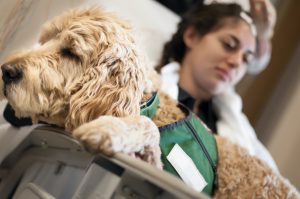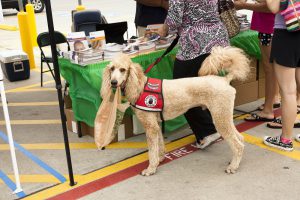Do Labradoodles make good therapy and service dogs?
Therapy and Service. That’s what they were bred for! Australian Labradoodles produces such wonderful qualities which make them a good companion – these same characteristics also make them excellent candidates for therapy/ service dogs. To become a therapy dog, you must assess your Labradoodles particular temperament, social and emotional skills and needs, and provide training based on that assessment. It’s important to note that not all dogs make good therapy dogs and not all dogs are appropriate for all therapy.
What is a Therapy Dog?

Therapy dogs also receive training but have a completely different type of job from service dogs. Their responsibilities are to provide psychological or physiological therapy to individuals other than their handlers. These dogs have stable temperaments and friendly, easy-going personalities. Typically, they visit hospitals, schools, hospices, nursing homes and more. Unlike service dogs, therapy dogs are encouraged to interact with a variety of people while they are on-duty including petting the therapy dog.
Therapy dogs may also visit schools, daycares, group homes and rehabilitation centers. Their roles vary from dogs who give learning disabled children the confidence to read out loud, to actively participating in physical rehabilitation therapy. In some cases, a therapy dog will work in an establishment exclusively, such as a psychotherapy practice.
Therapy dogs may be trained by just about anyone, but must meet set standards to be certified and registered and actively participate in the program. They are usually handled by their owners, but in some cases of Animal Assisted Therapy, the therapy dog may be handled by a trained professional.
Therapy and Service dogs has become an important tool in many types of ways. Therapy dogs are used in hospitals, schools and nursing homes. We focus on providing puppies that are prepared to become therapy and service dogs (Note: Therapy dogs are NOT service dogs).
What is a Service Dog?

Service Dogs are trained to perform tasks and to do work that eases their handlers’ disabilities. Working as part of a team with their disabled partners, service dogs help them attain safety and independence. It is very important to note that these dogs are not for petting as it could prevent them from performing their job correctly. Most service dogs have a “no petting” policy established by their owners.
The Americans with Disabilities Act (ADA) protects the rights of people with disabilities to be accompanied by their service dogs in public places such as restaurants, grocery stores, and hotels. Additional laws such as the Department of Transportation’s Air Carrier Access Act, the Housing and Urban Development’s Fair Housing Act, and the Federal Rehabilitation Act protect the rights of people with disabilities to be accompanied by their service animals in a wide variety of circumstances under which the ADA may not be applicable.
Do Service Dogs and Therapy Dogs Have the Same Legal Status?
Despite thorough training, registration and the therapeutic benefits therapy dogs provide, they do not have the same jobs or legal designation as service dogs. While some institutions offer therapy dogs access on a case-by-case for the benefit of patients, guests, customers or clientele, the handlers or owners of therapy dogs do not have the same rights to be accompanied by these dogs in places where pets are not permitted.
Service and therapy dogs provide much more than “jobs” for the disabled. Each of these animals provides their owners with the companionship and love that only a dog can give. Service Dogs are not pets.
ADA LAWS Service dog teams have civil rights against discrimination and harassment. The Department of Justice has issued revised ADA regulations which cover Title II (state and local government programs) and Title III (places of public accommodation, such as restaurants or retail merchants) , which took effect March 15, 2011. These regulations revise the definition of service animal and add additional provisions.
Definition
A service animal is any dog that is individually trained to do work or perform tasks for the benefit of an individual with a disability, including a physical, sensory, psychiatric, intellectual, or other mental disability. Other species of animals, whether wild or domestic, trained or untrained, are not considered service animals.
The work or tasks performed by a service animal must be directly related to the individual’s disability. Examples of work or tasks include, but are not limited to:
- Assisting individuals who are blind or have low vision with navigation and other tasks.
- Alerting individuals who are deaf or hard of hearing to the presence of people or sounds.
- Providing non-violent protection or rescue work.
- Pulling a wheelchair.
- Assisting an individual during a seizure.
- Alerting individuals to the presence of allergens.
- Retrieving items such as medicine or the telephone.
- Providing physical support and assistance with balance and stability to individuals with mobility disabilities.
- Helping individuals with psychiatric and neurological disabilities by preventing or interrupting impulsive or destructive behaviors.
The crime deterrent effects of an animal’s presence and the provision of emotional support, well-being, comfort, or companionship are not considered work or tasks under the definition of a service animal.
When and Where a Service Animal is Allowed Access?
Individuals with disabilities can bring their service animals in to all areas of public facilities and private businesses where members of the public, program participants, clients, customers, patrons, or invitees are allowed. A service animal can be excluded from a facility if its presence interferes with legitimate safety requirements of the facility (e.g., from a surgery or burn unit in a hospital in which a sterile field is required).
A public entity or a private business may ask an individual with a disability to remove a service animal if the animal is not housebroken or is out of control and the individual is not able to control it. A service animal must have a harness, leash or other tether, unless the handler is unable to use a tether because of a disability or the use of a tether would interfere with the service animal’s ability to safely perform its work or tasks. In these cases, the service animal must be under the handler’s control through voice commands, hand signals, or other effective means. If a service animal is excluded, the individual with a disability must still be offered the opportunity to obtain goods, services, and accommodations without having the service animal on the premises.
Asking Questions
To determine if an animal is a service animal, a public entity or a private business may ask two questions:
- Is this animal required because of a disability?
- What work or task has this animal been trained to perform?
These questions may not be asked if the need for the service animal is obvious (e.g., the dog is guiding an individual who is blind or is pulling a person’s wheelchair). A public entity or private business may not ask about the nature or extent of an individual’s disability or require documentation, such as proof that the animal has been certified, trained or licensed as a service animal, or require the animal to wear an identifying vest.

